效果展示
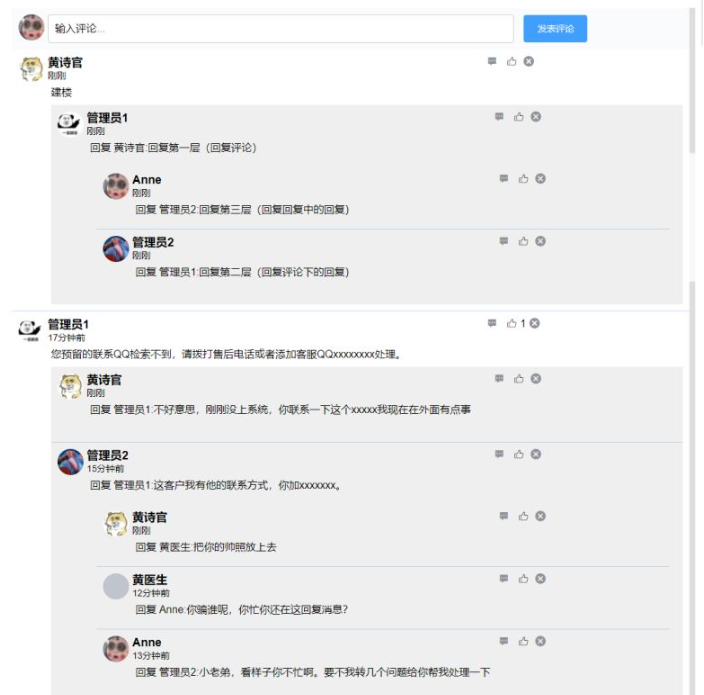
总共是两层回复 (回复评论、回复评论下的回复)
数据库设计
评论表(TFW_Comments)和回复内容表(TFW_UserResponse)以及评论回复关系表(TFW_MsgRelation)
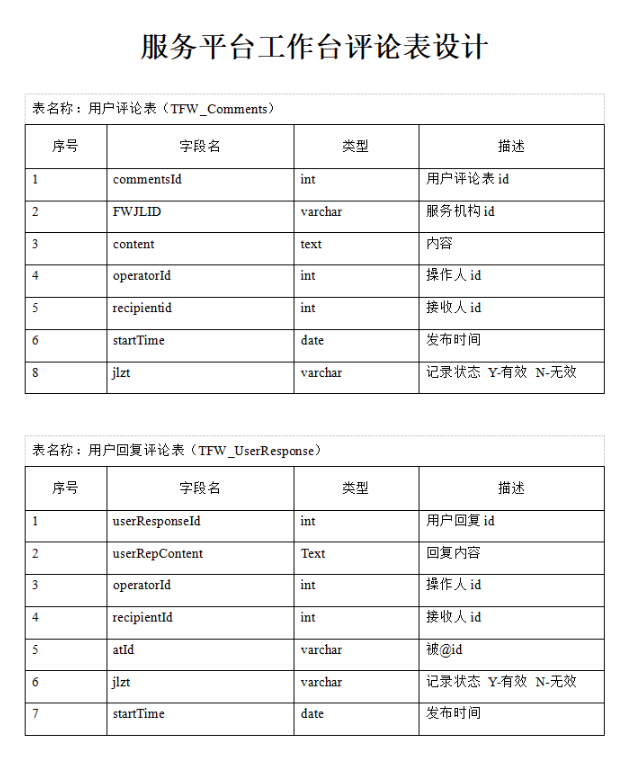
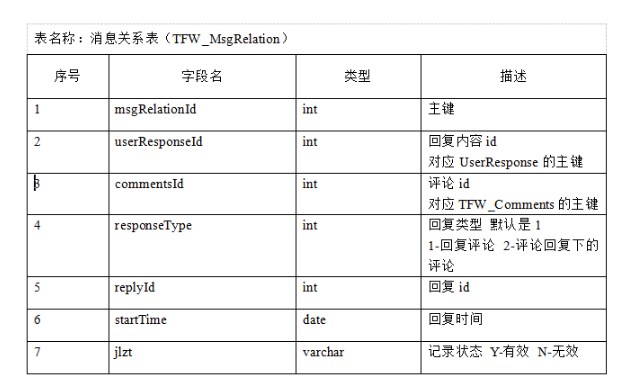
数据库设计思路:
注:各位读者自动忽略评论表的服务机构ID字段,这个字段相当于这条评论是在哪个帖子(文章下面)
1、根据文章ID或者是帖子ID查询评论表获取评论(本文的服务机构ID)。第一层(评论)
获取第二层回复(commentsId),需要根据评论ID并且回复类型等于1,在关系表中查询。第二层(评论下的回复)
根据评论ID、回复类型为2、以及回复ID在关系表中获取第三层回复信息。第三层(评论下回复中的回复)注:回复ID是它的上级
实现类源码
@Override
public Map<String, Object> findComments(JSONObject jsonObject) {
data.clear();
String userId = jsonObject.getString("userId");
String role = this.role(jsonObject);
if (role.equals("-1")){
//没有权限
data.put("error","-1");
data.put("msg","当前用户没有权限");
return data;
}
List<Map<String, Object>> info = commentsDao.findComment(jsonObject.getString("fWJLID"),null);
//查询点赞次数
int countTag = 0;
MsgRelationTag msgRelationTag = new MsgRelationTag();
for (Map item : info){
item.put("inputShow",false);
int commentsId = (int) item.get("commentsId");
//查询点赞次数
countTag = msgRelationDao.findCountTagByTagId(commentsId,1);
item.put("countTag",countTag);
//设置点赞状态
msgRelationTag.setTagId(commentsId);
msgRelationTag.setTagType(1);
msgRelationTag.setTagUserId(Integer.parseInt(userId));
MsgRelationTag msgTag = msgRelationDao.findMsgTag(msgRelationTag);
if (msgTag != null) {
item.put("tagStatus",msgTag.getStatus());
}else {
item.put("tagStatus","");
}
//如果有@id
if (item.get("atId") != null){
String content = item.get("content").toString();
StringBuffer tmrAtId = findUserName(item.get("atId").toString());
item.put("content",content+'@'+tmrAtId);
}
//二级回复数据
List<Map<String, Object>> twoReply = new ArrayList<>();
//所有数据
List<Map<String, Object>> userResponse = userResponseDao.findUserResponse(commentsId, null, "","",null);
for (Map userResponseInfo :userResponse){
int userResponseIds = Integer.parseInt(userResponseInfo.get("userResponseId").toString());
//查询点赞次数
countTag = msgRelationDao.findCountTagByTagId(userResponseIds,2);
//设置点赞状态
msgRelationTag.setTagId(userResponseIds);
msgRelationTag.setTagType(2);
msgTag = msgRelationDao.findMsgTag(msgRelationTag);
if (msgTag != null) {userResponseInfo.put("tagStatus",msgTag.getStatus());}else {userResponseInfo.put("tagStatus","");}
userResponseInfo.put("countTag",countTag);
userResponseInfo.put("inputShow",false);
Integer responseType = (Integer) userResponseInfo.get("responseType");
for (Map stairReplyInfo : userResponse){
Integer userResponseId = (Integer) stairReplyInfo.get("userResponseId");
int msgRelationId = Integer.parseInt(stairReplyInfo.get("msgRelationId").toString());
//接受者id*/
twoReply = userResponseDao.findUserResponse(msgRelationId, userResponseId,"1","",null); //二级回复数据
for (Map twoReplyItem : twoReply){
int twoReplyId = Integer.parseInt(twoReplyItem.get("userResponseId").toString());
twoReplyItem.put("inputShow",false);
//查询点赞次数
countTag = msgRelationDao.findCountTagByTagId(twoReplyId,2);
twoReplyItem.put("countTag",countTag);
//设置点赞状态
msgRelationTag.setTagId(twoReplyId);
msgTag = msgRelationDao.findMsgTag(msgRelationTag);
if (msgTag != null) {twoReplyItem.put("tagStatus",msgTag.getStatus());}else {twoReplyItem.put("tagStatus","");}
String userRepContent = twoReplyItem.get("userRepContent").toString();
if (twoReplyItem.get("tmrAtId") != null){
StringBuffer tmrAtId = findUserName(twoReplyItem.get("tmrAtId").toString());
twoReplyItem.put("userRepContent",userRepContent+'@'+tmrAtId);
}
}
stairReplyInfo.put("twoReply",twoReply);
}
}
item.put("stairReply",userResponse);
}
data.put("data",info);
data.put("error",0);
data.put("msg","查询成功");
return data;
}其它的代码可以忽略。主要语句有:
获取帖子下的评论
List<Map<String, Object>> info = commentsDao.findComment(jsonObject.getString("fWJLID"),null);上图根据FWJLID获取评论。(此处可以当成帖子的ID,获取帖子下的评论)一级展示
对应SQL语句(OPT是我的用户表)
select tc.content ,tc.commentsId,convert(varchar(19),tc.startTime,120) as startTime,tc.recipientId ,tc.operatorId,zo.NAME as operatorName,tc.atId,zo.HeadImgUrl as operatorHeadImgUrl
from TFW_Comments tc
left join zd_opt zo on zo.AID = tc.operatorId where tc.FWJLID = 5101查询结果:

获取评论下的回复
List<Map<String, Object>> userResponse = userResponseDao.findUserResponse(commentsId, null, "","",null);
上图根据commentsid获取评论下的回复。(根据评论ID获取回复)二级展示
对应sql语句
select
tur.userResponseId,tur.operatorId,tur.recipientId,convert(varchar(19),tur.startTime,120) as startTime,tur.userRepContent,tmr.atId as tmrAtId,
tmr.msgRelationId ,tmr.responseType,tmr.replyId,
zo.NAME as operatorName,
zo1.NAME as recipientName,
zo.HeadImgUrl as operatorHeadImgUrl,
zo1.HeadImgUrl as recipientHeadImgUrl
from TFW_MsgRelation tmr
left join TFW_UserResponse tur on tur.userResponseId = tmr.userResponseId
left join zd_opt zo on zo.AID = tur.operatorId
left join zd_opt zo1 on zo1.AID = tur.recipientId where tmr.commentsId = 47查询结果

获取二级回复
twoReply = userResponseDao.findUserResponse(msgRelationId, userResponseId,"1","",null); //二级回复数据
上图是根据评论ID(msgRelationId)和回复ID(userResponseId)去获取二级回复。回复ID也就是父类。就是回复那一条回复的ID。 第三层展示
对应sql
select
tur.userResponseId,tur.operatorId,tur.recipientId,convert(varchar(19),tur.startTime,120) as startTime,tur.userRepContent,tmr.atId as tmrAtId,
tmr.msgRelationId ,tmr.responseType,tmr.replyId,
zo.NAME as operatorName,
zo1.NAME as recipientName,
zo.HeadImgUrl as operatorHeadImgUrl,
zo1.HeadImgUrl as recipientHeadImgUrl
from TFW_MsgRelation tmr
left join TFW_UserResponse tur on tur.userResponseId = tmr.userResponseId
left join zd_opt zo on zo.AID = tur.operatorId
left join zd_opt zo1 on zo1.AID = tur.recipientId where tmr.commentsId = 136 and tmr.replyId = 155查询结果

返回页面展示和返回体展示
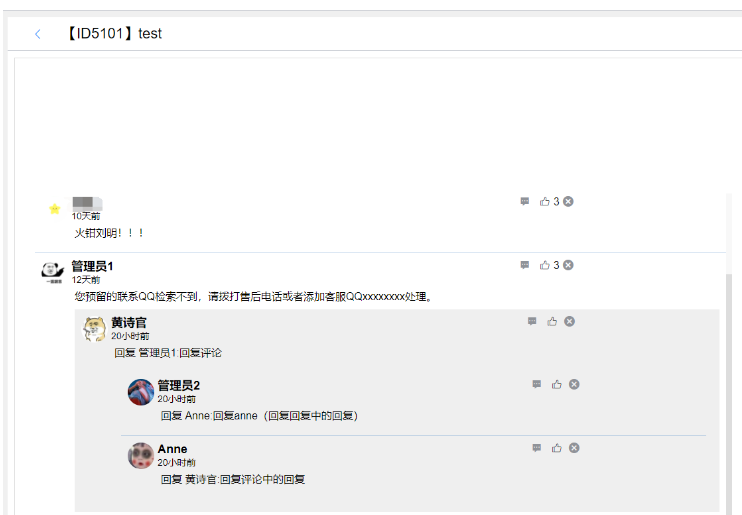
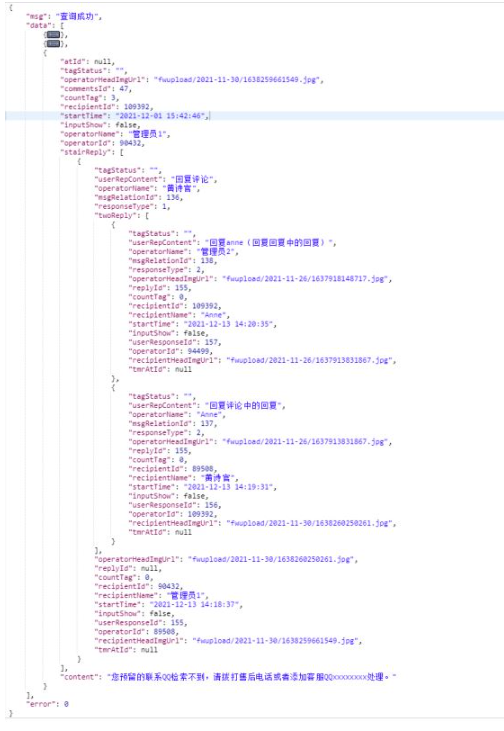
以上是java怎么实现评论和回复功能的详细内容。更多信息请关注PHP中文网其他相关文章!
 如何将Maven或Gradle用于高级Java项目管理,构建自动化和依赖性解决方案?Mar 17, 2025 pm 05:46 PM
如何将Maven或Gradle用于高级Java项目管理,构建自动化和依赖性解决方案?Mar 17, 2025 pm 05:46 PM本文讨论了使用Maven和Gradle进行Java项目管理,构建自动化和依赖性解决方案,以比较其方法和优化策略。
 如何使用适当的版本控制和依赖项管理创建和使用自定义Java库(JAR文件)?Mar 17, 2025 pm 05:45 PM
如何使用适当的版本控制和依赖项管理创建和使用自定义Java库(JAR文件)?Mar 17, 2025 pm 05:45 PM本文使用Maven和Gradle之类的工具讨论了具有适当的版本控制和依赖关系管理的自定义Java库(JAR文件)的创建和使用。
 如何使用咖啡因或Guava Cache等库在Java应用程序中实现多层缓存?Mar 17, 2025 pm 05:44 PM
如何使用咖啡因或Guava Cache等库在Java应用程序中实现多层缓存?Mar 17, 2025 pm 05:44 PM本文讨论了使用咖啡因和Guava缓存在Java中实施多层缓存以提高应用程序性能。它涵盖设置,集成和绩效优势,以及配置和驱逐政策管理最佳PRA
 如何将JPA(Java持久性API)用于具有高级功能(例如缓存和懒惰加载)的对象相关映射?Mar 17, 2025 pm 05:43 PM
如何将JPA(Java持久性API)用于具有高级功能(例如缓存和懒惰加载)的对象相关映射?Mar 17, 2025 pm 05:43 PM本文讨论了使用JPA进行对象相关映射,并具有高级功能,例如缓存和懒惰加载。它涵盖了设置,实体映射和优化性能的最佳实践,同时突出潜在的陷阱。[159个字符]
 Java的类负载机制如何起作用,包括不同的类载荷及其委托模型?Mar 17, 2025 pm 05:35 PM
Java的类负载机制如何起作用,包括不同的类载荷及其委托模型?Mar 17, 2025 pm 05:35 PMJava的类上载涉及使用带有引导,扩展程序和应用程序类负载器的分层系统加载,链接和初始化类。父代授权模型确保首先加载核心类别,从而影响自定义类LOA


热AI工具

Undresser.AI Undress
人工智能驱动的应用程序,用于创建逼真的裸体照片

AI Clothes Remover
用于从照片中去除衣服的在线人工智能工具。

Undress AI Tool
免费脱衣服图片

Clothoff.io
AI脱衣机

AI Hentai Generator
免费生成ai无尽的。

热门文章

热工具

SublimeText3汉化版
中文版,非常好用

SublimeText3 Mac版
神级代码编辑软件(SublimeText3)

适用于 Eclipse 的 SAP NetWeaver 服务器适配器
将Eclipse与SAP NetWeaver应用服务器集成。

EditPlus 中文破解版
体积小,语法高亮,不支持代码提示功能

DVWA
Damn Vulnerable Web App (DVWA) 是一个PHP/MySQL的Web应用程序,非常容易受到攻击。它的主要目标是成为安全专业人员在合法环境中测试自己的技能和工具的辅助工具,帮助Web开发人员更好地理解保护Web应用程序的过程,并帮助教师/学生在课堂环境中教授/学习Web应用程序安全。DVWA的目标是通过简单直接的界面练习一些最常见的Web漏洞,难度各不相同。请注意,该软件中






